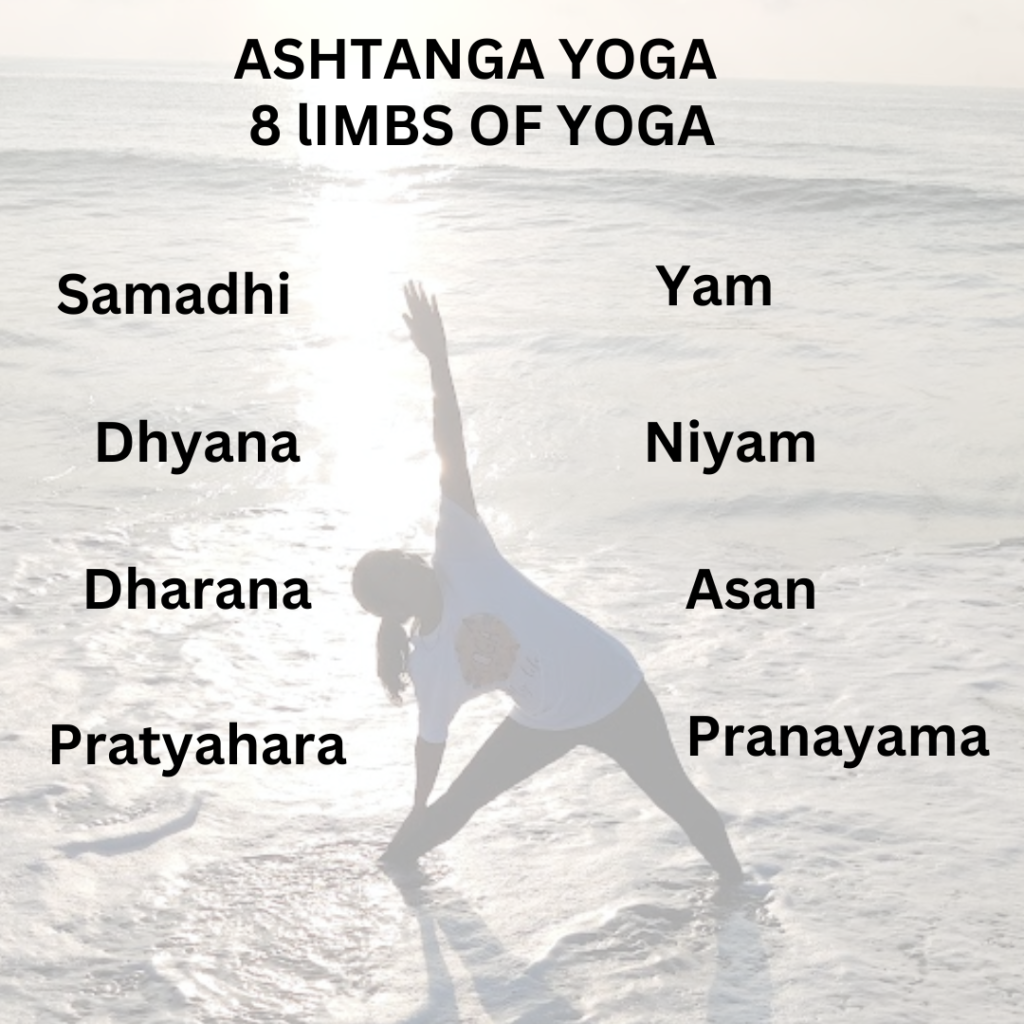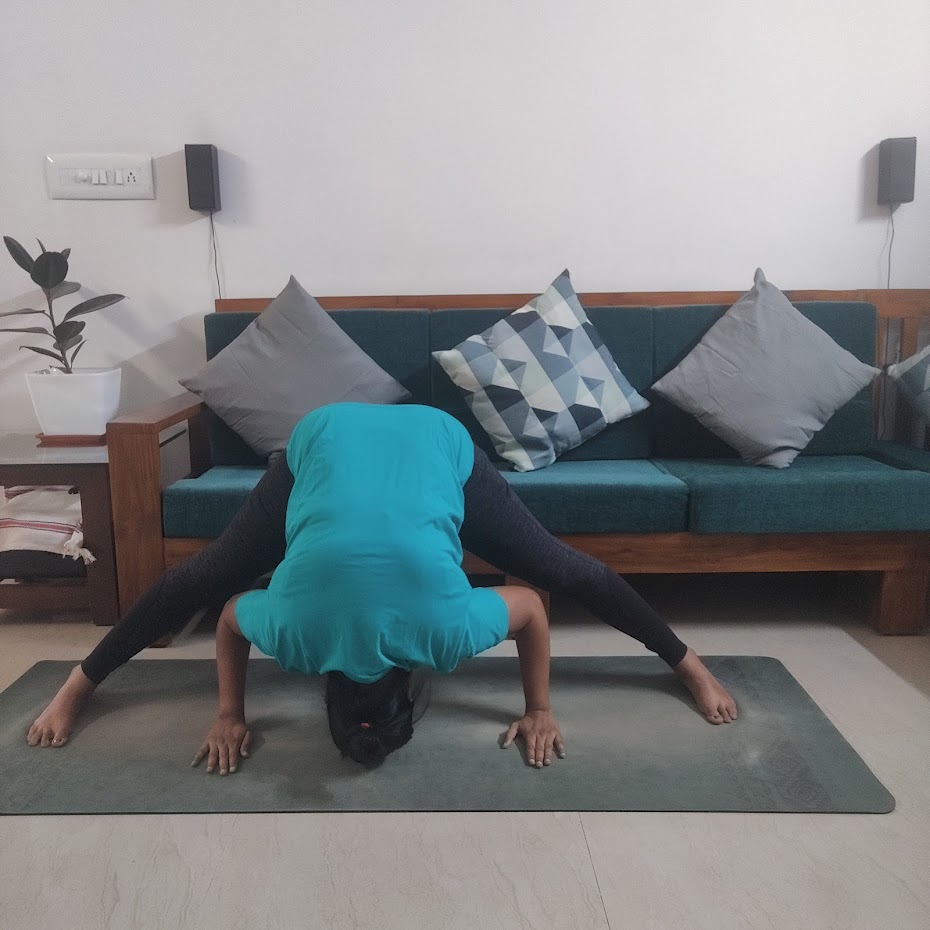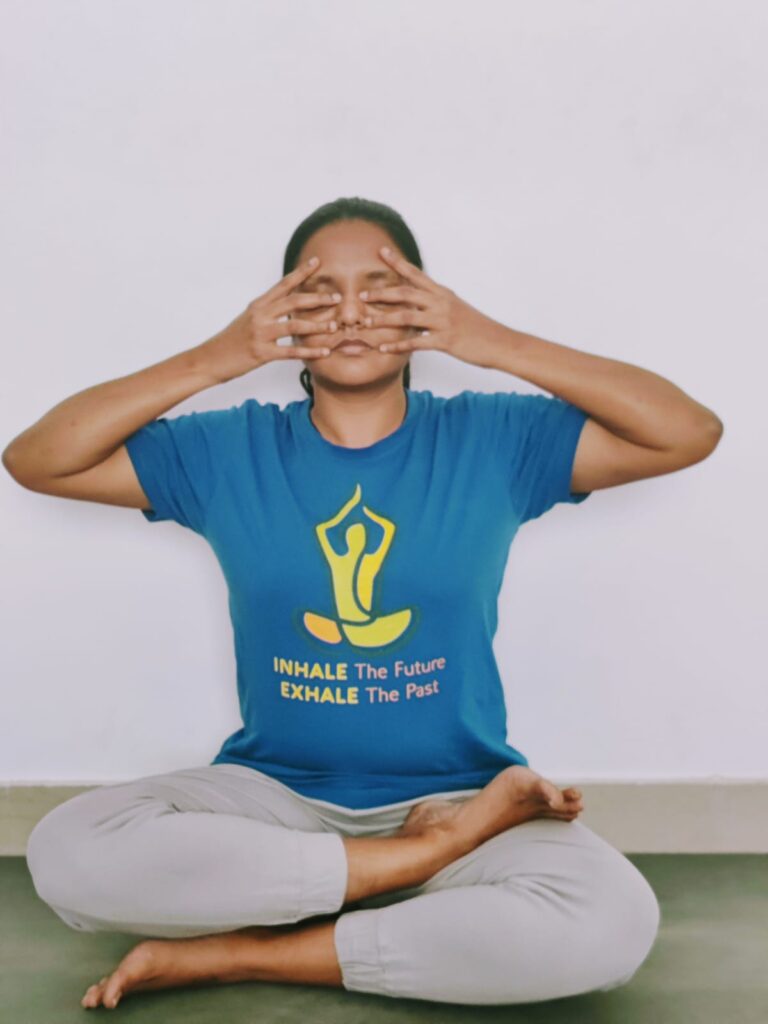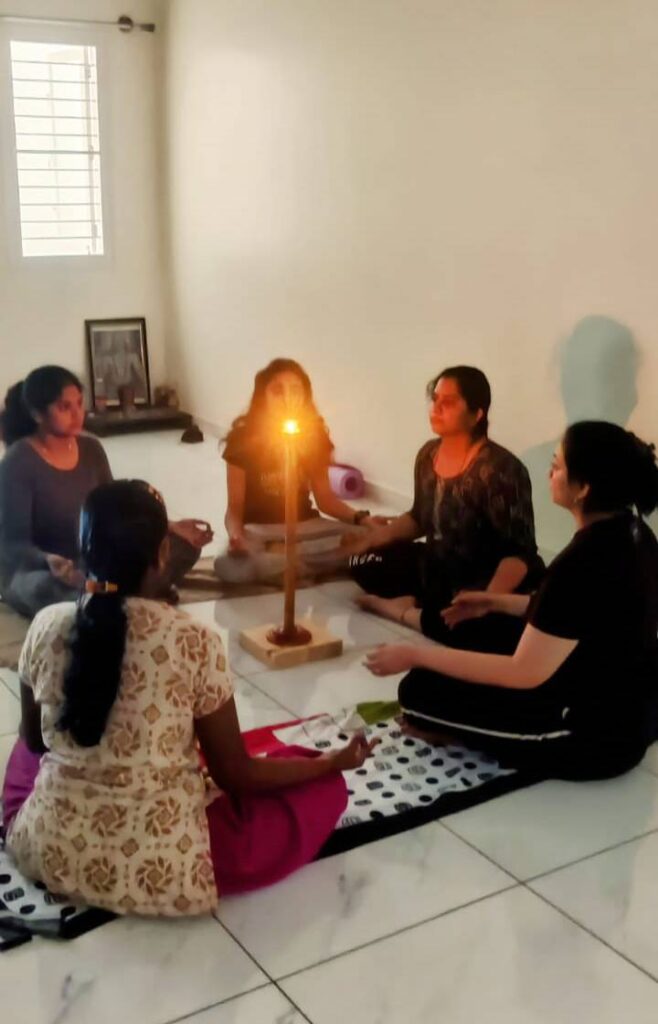Raja Yoga – The path of meditation, willpower, strength, and stability, a path that leads to samadhi.
In my last blog, I shared my experience on the path of bhakti yoga
This blog will discuss raja yoga and how it changed my life.
Raja yoga is all about mind and body control. it is also known as Ashtanga yoga (8limbs) of Maharishi Patanjali. We all were introduced to this as yogic practices, and as we go deeper and start practising we understand that it’s not about its course, but it’s how we implement raja yoga in our daily life.
My Experience
I was introduced to this path in my early 20s. The practice began a year after my daughter was born, I was diagnosed with cervical spondylitis and got to know that through asana practice I can get cured; as I started going for regular classes the practices helped me recover from cervical spondylitis, and became a regular practitioner of yoga since then.
Though I had heard about it from Anandmurti Gurumaa (an enlightened master) satsangs (discourses), I had never got a chance to practice before I was diagnosed, slowly going to yoga classes helped me to understand what Raja Yoga is in depth.
That was not the end, slowly I started exploring it more under the guidance of different yoga teachers and through the discourses of Anandmurti Gurumaa.
Raja Yoga is not all about asana pranayama practice indeed more than that, it is a path of discipline Yam Niyam the code of conduct is the most important practice that has to be followed, the day I understood this since then I am constantly trying my best to practice yama and niyama as it is not easy, it’s a lifetime process.
The practice of yam niyam has played a great role along with asana, and pranayama, pratyahara (yoga nidra practice), Dharana (guided meditation) in life, in fact, it gave me strength, stability, knowledge, wisdom, clarity, it showed me my faults and through sadhana, it’s becoming easy to overcome them.
Play of karma in my sadhana
As it is said karma plays a major role in each one of our lives, and it played in my life too, The six months of the intense sadhana of all the above yogic practices made me Egoistic, that I am the doer whatever I say is right, I wake up in bhramamuhurat so on… so it was all time me me me,
Of course, all of us learn from mistakes and so did I, This situation had to come into my life to change me.
Suddenly I met with an accident an iron rode fell on my toe, and the toe was almost cut, I was on bed rest for a month and had to stop all yogic practices but yet continued with shwadhyaya and that dissolved my ego, it was a learning phase for me learned to accept every situation came my way and became stronger emotionally.
Being on bed rest for a month a realisation happened that this is not me it is just part of this body. It’s a body which will turn into ashes then why this ego, why hold grudges… let’s learn to surrender, forgive, love & serve each other, and accept each one as they are why judge others everyone is born with their own karma.
We all have to bare the fruit of our actions and if we accept them with compassion, we will be able to heal ourselves and move towards the higher consciousness and liberate ourselves from birth and death.
Yes, I would say this doesn’t mean we should stop performing our duties towards our loved ones or stopping loving them, in fact, our love towards them will be more, pure and unconditional. we will accept them as they are and help them grow.
THE IMPACT OF MY SADHANA
Raja Yoga Marga helped me find all my faults which were in my deep subconscious mind and slowly worked on them with many ups & downs, today I have learnt to love, be compassionate let go, overcome all my guilt and live life in peace & harmony. Though it was not an easy process many challenges came my way besides which the raja yoga practices kept me strong and gave me the strong willpower to overcome every situation.
This is a long journey, never-ending and I will keep walking on this path till my last breath.
It is a path that leads to Moksha. we need to work hard to reach the last two limbs (dhyana, samadhi) Only time can take us there, we need a lot of purification and the physical and mental level.
At last, I would say I am leaner and will be a learner
let me brief you all on the 8 limbs of Raja Yoga

Ashtanga yoga or raja yoga is also a path towards self-realisation, Like bhakti, jnana, and karma yoga.
The Yama – The first step of the code of conduct
This is done by practising various ethical and moral disciplines.
The Yama are:-
Satya- Truth
Ahimsa- Non-violence
Asteya – Non-Stealing
Aparigraha – Non- Hoarding
Brahmacharya – Celibacy, Moderation
The Niyama’s:- The Second Step Of Code Of Conduct
This helps to cultivate good habits in us, to improve the quality of our mind and make it stronger.
The Niyamas are:
- Saucha- Cleanliness ( internal & external)
2. Santosha- Contentment
3. Tapas- Austerities
4. Shavdhyaya – Self-Study Of Scripture
5. Ishvara Paridhana- Surrendering To God
Asana – The Third Limb Of Ashtanga Yoga

Here Asana does not only refer to various postures. It means a suitable posture in which a person can sit with the spine erect for a long duration of time. It brings balance and stability to the body,
The aim of practising asana should be to bring Ekagrata (one-pointedness). & further Prepare ourselves to sit in Pranayama, Dharana, & Dhyana without any physical discomforts. As physical discomforts bring disturbances to the body and interfere with meditation.
Pranayama The Fourth Limb Of Ashtanga Yoga

Pranayam is the most popular practice of yoga. Pranayama is defined as prana+ayama.
Prana: means life force, energy, life breath, or vitality.
Ayama: means stretch, expansion, control, and restraint. Prana + Ayama means expansion of breath and then control it.
The traditional view of pranayam is seen as kumbhaka (breath retention).
Pranayama is all about breath modulation, which is a process of making involuntary breath into voluntary breath. Pranayam along with breath modulation is also the modulation of life management. It does not just help at the physiological level but at the level of emotional and spiritual level, it has its impact.
ADI SRI SANKARACHARYA says “Pranayam practice does carry physical components but it is not its limit”. Indeed, it is the science of universal energy, mind, space, &time. Therefore, one cannot limit it to the science of breathing. Pranayam is the means through which yogi attains perfection in this little body by realising it as whole cosmic life.
Pratyahara The Fifth Limb Of Ashtanga Yoga

Pratyahara is the practice of withdrawing of senses from material objects, This withdrawal can happen when the mind is still and calm, You can withdraw your senses from worldly objects, by exercising tremendous willpower. One of the yogic practices that help you to achieve the state of pratyahara is yoga nidra.
The Bhagvad Geeta Says:-
The Restless and turbulent mind can be controlled by relentless Abhyasa (practice) and through vairagya i.e the absence of desire for objects of sense pleasure
Pratyahara matures into Dharana.
Dharana The Fifth Limb Of Ashtanga Yoga

Dharana means fixing the mind on the object, the object can be your diety’s or picture idol, and it can be becoming aware of the body parts and fixing your concentration on any one part of your body, I would say or the Agyan chakra (third eye chakra, between the eyebrows)Dharana is the preliminary stage of meditation, when we steadfastly cling our mind to object, we are ready to go to next higher step, Dhyana (meditation).
When Dharana Matures Dhayana Happens.
Dhyana The Seventh Limb

Dhyana is not something that can be practised it is a state of being in the presence of a state where the mind is completely quiet and calm, its the state where you connect with your soul, In my view, Dhyana happens we do not need to practice its like when we perform every action with complete dedication without having a single thought in mind, say for e.g we cook and while cooking we become aware of the whole process from washing the veggies, chopping and prepare even a minute process like adding spices salt etc.
So before getting into dhyana one needs to understand their mind and its characteristics in detail, which can only happen with all the above practices.
Once all the above yogic practices start getting matured it automatically leads us to the state of Dhyana. This can happen only under the guidance of the Guru. The Guru can only guide us and show us the path of truth, guidance of the Guru can help us understand where we stand in our sadhana (spiritual practice)
Dhyana Matures into Samadhi
Samadhi The Eighth Limb

Samadhi is the eighth limb the last stage of Ashtanga yoga, though samadhi cannot be explained in words until we experience it, it is a state of higher consciousness where all the quest of sadhaka ends,
It is a state where a person has gone beyond consciousness, his body and mind are at rest as if he is asleep, but the faculties of the mind our conscious and alert, as in the yogi is fully conscious and alert though his mind & body are rest.
Conclusion
The practice of raja yoga or Ashtanga yoga helps us to overcome all the obstacles of this life and reach higher consciousness, remember to practice them under the guidance of a teacher or a yoga guru.
Self-practice makes us egoistic, there is not much clarity or awareness and the mind plays games with us, we often get into dilemmas and start practising what we are not supposed to. Hence Guidance of the Guru is a must to succeed in the path of Raja Yoga
Very soon i will be explaining about Yama, and Niyamas in detail and how they helping me.
Take Away
- Take baby steps to start with a spiritual journey, be slow and steady.
- Follow the moral and ethical values exercise them and practice asana, pranayama pratyahara, pranayama &dharana first under the guidance of your Guru.
- Study the mind, find its hidden defects and effectively eliminate them. Only a pure mind can achieve the state of dhyana and samadhi.
- Be consistent in all your yogic practices.
Maharishi Patanjali withdraws our attention to another important fact, He says "The flow of continuouscontrol of the mind becomes steady when practiced regularly day by day".
Enthusiasm and regularity in practice are very essential.
We all must know that purpose of yoga is not all about just its physical and mental aspects but its to experience divinity, the highest goal of the spiritual life. by attaining it we learn to live in harmony, one becomes perfect and satisfied forever.
Yoga Sutras also makes a striking point that goal of meditation can be achieved by Raja yoga nd Bhakti yoga.
Come Let’s walk together on this path and live this life in harmony and balance
Let’s learn to be compassionate, kind,
Come lets us love and serve each other


